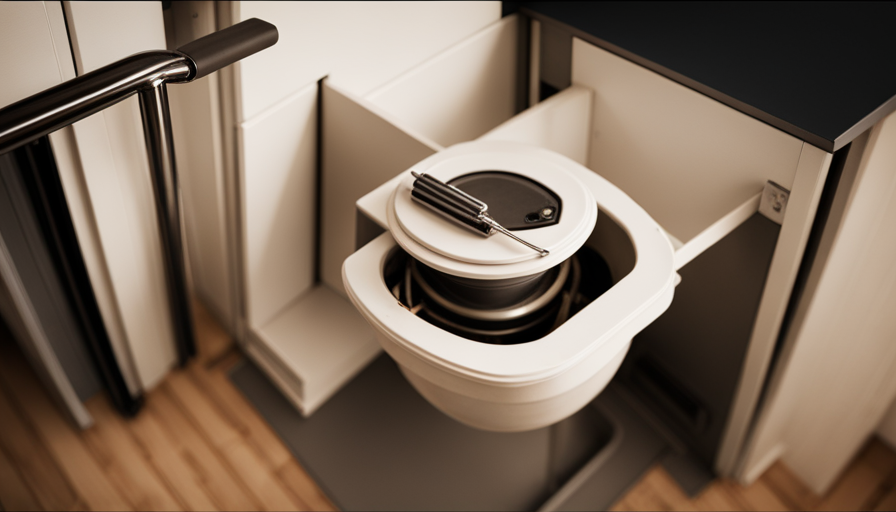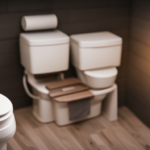Did you know that the average person uses about 27,000 gallons of water each year just by flushing the toilet? This is a significant amount, especially considering the growing emphasis on water conservation and living a sustainable lifestyle.
In my research on tiny house living, I discovered an intriguing solution to this issue – compost toilets. These innovative toilets not only save a significant amount of water but also offer a sustainable and eco-friendly alternative to traditional flush toilets.
In this article, we will explore how compost toilets work in tiny houses, delving into the fascinating world of microorganisms, the separation of liquid and solid waste, proper ventilation, odor management, and compost harvesting. We will also compare the environmental impact of compost toilets to traditional flush toilets and discuss the benefits and drawbacks of using compost toilets in tiny house living.
So, let’s dive into the world of compost toilets and discover how they can revolutionize the way we think about waste management in our homes.
Key Takeaways
- Compost toilets in a tiny house save water and offer a sustainable alternative to flush toilets.
- They break down waste into nutrient-rich compost through decomposition, reducing water consumption and minimizing pollution.
- Compost toilets separate liquid and solid waste, reducing water usage by up to 90% and treating liquid waste for use as fertilizer.
- However, they require proper ventilation, regular cleaning, and the addition of carbon-rich materials for odor control and composting efficiency.
Understanding the Basics of Compost Toilets
A compost toilet works by breaking down waste into nutrient-rich compost through the process of decomposition. Instead of relying on water to flush waste away, compost toilets utilize microbial activity to break down the solid waste and transform it into compost.
The composting process in a compost toilet involves a combination of heat, moisture, and oxygen to create an environment that supports the growth of beneficial bacteria and other microorganisms.
When waste is deposited into a compost toilet, the microbial activity begins to occur. The microorganisms present in the toilet break down the waste materials, such as feces and toilet paper, into simpler organic compounds. This process is facilitated by the right balance of carbon and nitrogen-rich materials, as well as the proper moisture content.
The composting process in a compost toilet is similar to that which occurs in traditional composting systems. The waste materials undergo a series of biological and chemical reactions, resulting in the breakdown and transformation of the waste into compost. This compost can then be safely used as a fertilizer for plants or disposed of in an environmentally friendly manner.
Understanding the role of microorganisms in the composting process is crucial for the effective functioning of a compost toilet. These microorganisms play a vital role in breaking down the waste and converting it into compost.
The Role of Microorganisms in the Composting Process
Microorganisms play a crucial role in the composting process within a compact living space. These tiny organisms, such as bacteria, fungi, and protozoa, are responsible for breaking down organic matter into nutrient-rich compost. One key aspect that influences the work of these microorganisms is temperature control.
Compost toilets in tiny houses often utilize a system that maintains an optimal temperature range for the microorganisms to thrive. This can be achieved through insulation and the use of ventilation systems to regulate heat.
The benefits of using compost toilets in off-grid living cannot be overstated. Firstly, they’re environmentally friendly, as they help to reduce water consumption and minimize pollution. Secondly, they provide a valuable source of nutrient-rich compost that can be used in gardening and landscaping. Additionally, compost toilets offer a practical solution for those living in remote locations or areas with limited access to traditional sewage systems.
Transitioning to the next section, the separation of liquid and solid waste in compost toilets is another important aspect of their functionality.
Separation of Liquid and Solid Waste in Compost Toilets
One interesting statistic about the separation of liquid and solid waste in compost toilets is that it can reduce water usage by up to 90%. This is achieved through various separation techniques that ensure efficient liquid waste management.
Here are some key points to help you understand how the separation process works:
-
Gravity-based separation: Compost toilets are designed with a sloping surface that allows liquid waste to flow down into a separate container. This ensures that the solid waste remains dry and facilitates the composting process.
-
Diverting urine: Many compost toilets have a separate urine collection system that diverts the liquid waste away from the solid waste. This helps prevent odor and allows for easier management of both types of waste.
-
Liquid waste treatment: The collected urine can be treated separately through processes such as dilution, filtration, or composting. This helps eliminate pathogens and reduces the risk of contamination.
-
Nutrient-rich liquid fertilizer: Once treated, the liquid waste can be used as a valuable resource in gardening and agriculture. It’s rich in nutrients like nitrogen, phosphorus, and potassium, which are essential for plant growth.
Proper separation of liquid and solid waste in compost toilets is crucial for maintaining a hygienic and sustainable waste management system. However, it’s equally important to consider the role of proper ventilation in ensuring odor control and promoting the composting process.
The Importance of Proper Ventilation in Compost Toilets
To ensure effective waste management and prevent unpleasant odors, it’s important to prioritize proper ventilation in your compost toilet. Proper ventilation plays a crucial role in the functioning of a compost toilet by promoting the aerobic decomposition of waste and minimizing odors.
One way to achieve proper ventilation is by installing a vent pipe that extends from the compost toilet to the outside of the tiny house. This vent pipe allows for the release of moisture and gases, such as carbon dioxide and methane, that are produced during the decomposition process. By removing these gases, the compost toilet remains odor-free.
In addition to the vent pipe, some compost toilets also utilize a fan or a vent stack to further enhance ventilation. These additional mechanisms help to increase air circulation and promote the drying of the compost, which is important for the decomposition process.
Proper ventilation not only helps to minimize odors but also contributes to the overall hygiene of the compost toilet. By maintaining a well-ventilated environment, the growth of bacteria and other pathogens is inhibited, reducing the risk of contamination.
With proper ventilation in place, the compost toilet can effectively manage waste and maintain a hygienic environment. In the next section, we will explore various methods for managing odor and maintaining hygiene in compost toilets.
Managing Odor and Maintaining Hygiene in Compost Toilets
To effectively manage odor and maintain a hygienic environment in your compost toilet, you need to implement strategies that keep the space fresh and clean. Managing odor control is crucial in ensuring a pleasant experience.
One way to achieve this is by regularly adding carbon-rich materials, such as sawdust or wood shavings, to the toilet bowl after each use. These materials help absorb moisture and neutralize odors.
Additionally, maintaining cleanliness is essential for a healthy composting process. It’s important to clean the toilet regularly, ensuring that the interior surfaces are free from any waste buildup. This can be done using eco-friendly cleaning products that are safe for the composting process. Regularly emptying the compost bin is also crucial to prevent any unpleasant odors from developing.
Proper ventilation plays a significant role in managing odor and maintaining cleanliness. It’s essential to ensure that the compost toilet is well-ventilated to allow for proper airflow. This can be achieved by installing vents or fans that help circulate fresh air and remove any unpleasant odors.
By effectively managing odor control and maintaining cleanliness, you can create a pleasant and hygienic environment in your compost toilet. This sets the stage for the next step, which is adding carbon-rich materials to aid in the composting process.
Adding Carbon-rich Materials to Aid in the Composting Process
When it comes to managing odor and maintaining hygiene in compost toilets, there are several strategies that can be employed. However, one key aspect that shouldn’t be overlooked is the addition of carbon-rich materials to aid in the composting process.
Carbon-rich materials, such as sawdust, wood chips, or shredded newspaper, play a crucial role in balancing the nitrogen-rich waste in the compost toilet. These materials provide the necessary carbon to create the right environment for beneficial bacteria to thrive and break down the organic matter effectively. They also help to absorb excess moisture, prevent the formation of unpleasant odors, and maintain the proper moisture content in the compost pile.
As a tiny house dweller, I’ve found that regularly adding carbon-rich materials to my compost toilet has made a significant difference in odor control and overall composting efficiency. I make sure to keep a good supply of sawdust nearby and add a generous amount after each use. This not only helps with odor management but also aids in the decomposition process, allowing for the production of high-quality compost.
Now that we’ve covered the importance of carbon-rich materials in the composting process, let’s explore the next step: when and how to harvest compost from a compost toilet.
When and How to Harvest Compost from a Compost Toilet
Once you’ve reached the appropriate composting time frame, you can easily harvest the nutrient-rich compost from your compost toilet. Harvesting compost from a compost toilet is important because it allows you to utilize the valuable nutrients that have been broken down from organic waste.
To begin, make sure the compost has had enough time to decompose. This usually takes around six months to a year, depending on the composting techniques used and the temperature of the environment. Once the compost is ready, remove the composting container from the toilet system and take it to an outdoor area where you can easily work.
Next, use a shovel or pitchfork to gently turn the compost and break up any clumps. This will help aerate the compost and speed up the final decomposition process. After turning the compost, sift it through a fine mesh screen or use your hands to remove any large debris or undecomposed material.
Lastly, transfer the harvested compost to a storage bin or directly to your garden beds. This nutrient-rich compost will improve soil fertility and help your plants thrive. Now that you’ve successfully harvested compost from your compost toilet, let’s move on to the next section where we’ll discuss compost toilet maintenance and troubleshooting tips.
Compost Toilet Maintenance and Troubleshooting Tips
Now that we’ve harvested the nutrient-rich compost, let’s explore some tips for maintaining and troubleshooting your compost toilet. Keeping your compost toilet in good working order is essential for its efficient operation and odor-free experience.
Here are some compost toilet maintenance tips to ensure everything runs smoothly:
-
Regularly monitor the moisture level: Compost toilets work best when the moisture content is balanced. Too much moisture can lead to a foul smell, while too little can slow down the composting process. Use a moisture meter to check the moisture level and adjust accordingly.
-
Stir the compost regularly: Mixing the compost helps with decomposition and prevents any potential odor issues. Use a composting tool to stir the pile regularly, ensuring proper airflow and even decomposition.
-
Troubleshooting odor problems: If you notice any unpleasant odors, it could be a sign of improper ventilation. Check the ventilation system and ensure it’s working correctly. You may need to clean or replace the fan or adjust the vent pipe to improve airflow.
By following these compost toilet troubleshooting and maintenance tips, you can ensure your compost toilet functions effectively and odor-free. Now, let’s delve into comparing the environmental impact of compost toilets and traditional flush toilets.
Comparing the Environmental Impact of Compost Toilets and Traditional Flush Toilets
To truly understand the impact your choice of toilet has on the environment, you must compare the ecological footprint of compost toilets and traditional flush toilets. Compost toilets are an eco-friendly alternative that can significantly reduce water usage and the pollution that comes with it. Unlike traditional flush toilets, which require large amounts of water to operate, compost toilets use little or no water at all. This water conservation is a major advantage, especially in areas where water scarcity is a concern.
Compost toilets work by separating solid waste from liquid waste. Solid waste is stored in a separate compartment or container, where it undergoes a natural decomposition process. This process is facilitated by the presence of oxygen, moisture, and bacteria, which break down the waste into nutrient-rich compost. The resulting compost can then be safely used as fertilizer for plants or disposed of in an environmentally friendly manner.
In comparison, traditional flush toilets use water to transport waste through a sewage system. This water is often treated with chemicals and requires energy-intensive processes to remove contaminants. Additionally, traditional flush toilets contribute to water pollution by adding large volumes of waste to already overburdened sewage systems.
Considering the benefits and drawbacks of compost toilets in tiny house living, it’s clear that they offer a sustainable and environmentally responsible option. However, it’s important to also weigh the maintenance requirements and potential odor issues that may arise when using compost toilets in a confined space.
Considering the Benefits and Drawbacks of Compost Toilets in Tiny House Living
Imagine living in a small, sustainable home where you can minimize your ecological footprint and still enjoy the comforts of modern living. One way to achieve this is by installing a compost toilet in your tiny house. Compost toilets have become increasingly popular among off-grid enthusiasts and those looking to live a more eco-friendly lifestyle.
One of the main benefits of compost toilets in off-grid living is that they don’t require any water for flushing. This not only conserves water but also eliminates the need for a complicated plumbing system. Compost toilets also convert human waste into compost, which can be used as a nutrient-rich fertilizer for plants. This closed-loop system reduces the need for chemical fertilizers and helps to replenish the soil.
However, there are also some drawbacks to using compost toilets in small living spaces. One of the main challenges is managing the composting process. It requires regular maintenance and monitoring to ensure that the waste is breaking down properly and doesn’t emit any unpleasant odors. In addition, compost toilets may not be suitable for everyone, especially those with certain health conditions or mobility issues.
Compost toilets offer several benefits for off-grid living, such as water conservation and nutrient recycling. However, they also come with drawbacks, including the need for regular maintenance and potential limitations for certain individuals. It’s important to carefully consider these factors before installing a compost toilet in a tiny house.
Frequently Asked Questions
Can a compost toilet be used in a tiny house that is not off-grid?
Yes, a compost toilet can be used in a tiny house that isn’t off-grid. However, it’s important to consider compost toilet regulations in your area. Compost toilets are eco-friendly and have several benefits for tiny house living. They save water, eliminate the need for a septic system, and produce nutrient-rich compost for gardening. Additionally, they’re odorless and require minimal maintenance. Overall, compost toilets are a sustainable and practical option for tiny house dwellers.
Is there a specific type of microorganism that is used in compost toilets?
There are various types of microorganisms used in compost toilets, including bacteria, fungi, and protozoa. These microorganisms play a crucial role in the decomposition process, breaking down organic matter and converting it into nutrient-rich compost.
By using microorganisms, compost toilets are able to efficiently and effectively break down waste, eliminate odor, and reduce the volume of waste. This not only helps in maintaining a clean and odor-free environment but also promotes sustainable waste management in tiny houses.
How often should the liquid and solid waste be separated in a compost toilet?
The separation of liquid and solid waste in a compost toilet is essential for efficient composting. The frequency of separation depends on the design and capacity of the toilet, but generally, it should be done regularly to maintain proper composting conditions.
In most compost toilets, the separation process is achieved through a system of trays or containers. The liquid waste is diverted into a separate collection chamber, while the solid waste remains in the main compartment. This separation prevents odor and allows for effective decomposition.
Can a compost toilet be installed in a tiny house without proper ventilation?
Without proper ventilation, installing a compost toilet in a tiny house would be like trying to grow a garden without sunlight. Ventilation is crucial for the composting process to work effectively. It allows for the proper flow of air, which is essential for the breakdown of waste and the prevention of odors. Additionally, proper ventilation helps to regulate moisture levels, which is important for the composting process. So, if you want to enjoy the benefits of composting toilets in your tiny house, proper ventilation is a must.
Are there any specific cleaning products that should be used to maintain hygiene in a compost toilet?
When it comes to maintaining cleanliness in a compost toilet, there are a few best practices to keep in mind. Firstly, it’s important to regularly empty and clean the composting chamber to prevent odors and ensure proper decomposition.
Secondly, using eco-friendly cleaning products is crucial to maintain the natural balance of the composting process. Harsh chemicals can disrupt the decomposition process and harm beneficial microorganisms. Opt for natural cleaners like vinegar or baking soda to maintain hygiene in your compost toilet.
Conclusion
In conclusion, compost toilets are an innovative and sustainable solution for tiny house living. They function by utilizing the natural process of composting, with microorganisms breaking down waste into nutrient-rich compost.
One interesting statistic to note is that compost toilets can save an average of 6,600 gallons of water per year compared to traditional flush toilets. By implementing compost toilets, not only can we reduce our water consumption, but also minimize our environmental impact.
With proper maintenance and understanding, compost toilets can be a practical and eco-friendly choice for tiny house owners.
Hi, I’m Emma. I’m the Editor in Chief of Tiny House 43, a blog all about tiny houses. While tree houses are often associated with childhood, they can be the perfect adult retreat. They offer a cozy space to relax and unwind, surrounded by nature. And since they’re typically built on stilts or raised platforms, they offer stunning views that traditional homes simply can’t match. If you’re looking for a unique and romantic getaway, a tree house tiny house might just be the perfect option.
















